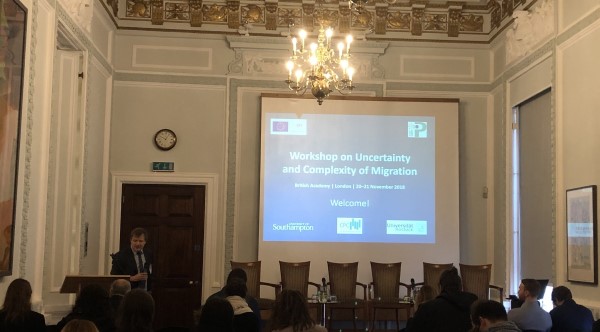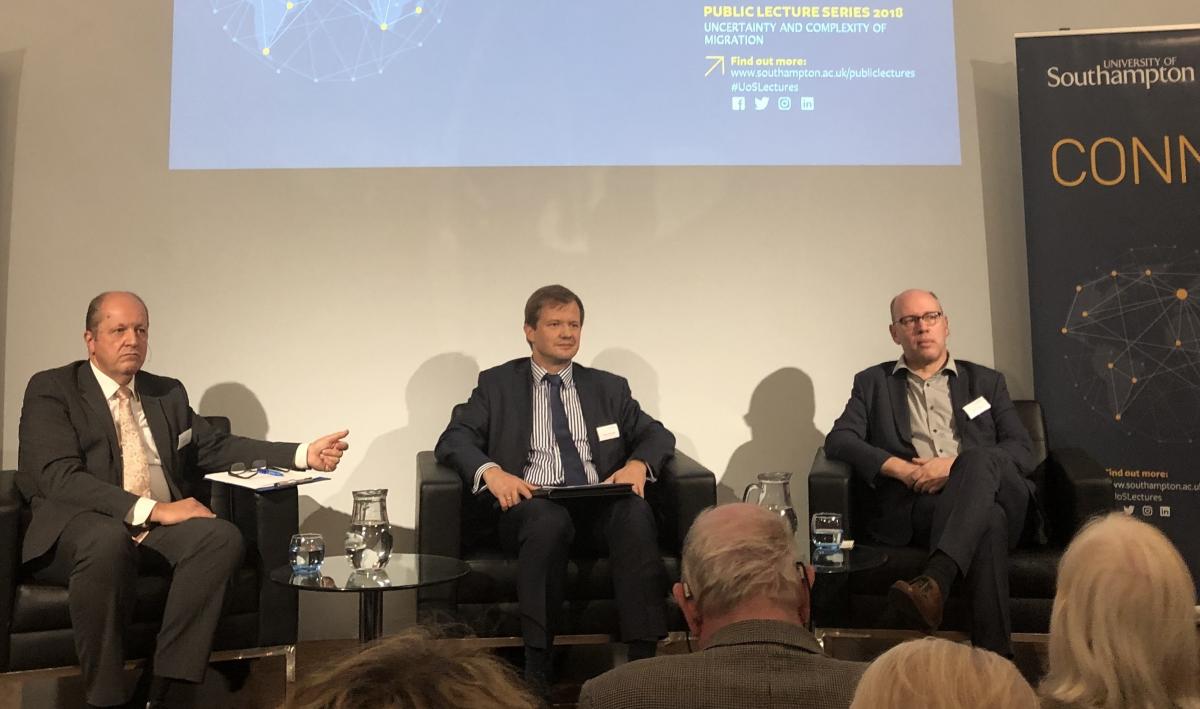Uncertainty and Complexity of MigrationLondon, United Kingdom, 20–21 November 2018
The Workshop on Uncertainty and Complexity of Migration took place in London, at the British Academy, on 20–21 November 2018. The workshop was organised as a part of the ERC project on Bayesian Agent-Based Population Studies, under the auspices and with support of the International Union for the Scientific Study of Populations (IUSSP), within the remit of the IUSSP Panel on Microsimulation and Agent-Based Modelling in Demography. Organisational support has been kindly provided by the ESRC Centre for Population Change. The evening public lecture on 20 November was organised and sponsored by the University of Southampton.
The workshop had two aims. The first aim was to summarise the state of the art in addressing the complexity and uncertainty of migration through formal modelling, and to present current research developments as well as opportunities in this area. The second aim was to discuss the best ways for modelling migration, directions for data collection, and conditions for making the modelling useful for policy support. In total, 36 participants representing both academic and policy spheres took part in the discussions. After the workshop, we received a lot of positive feedback from the participants, both regarding the organisation and the scientific content.

Day 1 The first day was opened by Jakub Bijak (University of Southampton) with an introductory talk on “Uncertainty and complexity in migration and its models”, followed by a presentation on “Data and Knowledge for Modelling Forced Migration”, authored by Sarah Nurse (Southampton). The latter was subsequently discussed by Ann Singleton (University of Bristol).
The following sessions included talks about: “Modelling migration”, presented by Martin Hinsch (Southampton) and discussed by Eric Silverman (University of Glasgow), “Decision making in migration models”, presented by Toby Prike (Southampton) and discussed by Frans Willekens (NIDI), and “Computer languages for simulating migration” by Oliver Reinhardt and Adelinde Uhrmacher (University of Rostock), with Sabine Zinn (Leibniz Institute for Educational Trajectories) acting as a discussant.
The late afternoon session included six contributed snapshot talks on various aspects and recent advances in migration modelling and in studying human decisions, from a range of academic speakers representing different scientific disciplines. The talks included: “Modelling migration during trait evolution in evolutionary biology” by Rebecca Hoyle (University of Southampton); “Identifying refugees in nationally representative datasets” by Sarah Miller (Penn State University); “Estimating migration flows at the local level in the US” by Ernesto Amaral (Texas A&M University); “European migration to the UK in the light of Facebook data” by Francesco Rampazzo (University of Southampton); “Microsimulations for multidimensional population projections in Europe” by Guillaume Marois (IIASA); and “How group composition affects group decisions” by Martina Testori (University of Southampton). The organisers regret that the scheduled talk on “Impact of the influx of Central African Refugees into Cameroon” by Fabien Sundjo (African Economic Research Consortium) could not be delivered at the workshop due to his UK visa not being available on time.
In the evening, the participants took part in the 2018 Southampton Public Lecture on “Uncertainty and Complexity of Migration”, which was held in conversation between Jon Simmons (Home Office) and Jakub Bijak, and moderated by Charles Elder (University of Southampton). The lecture was attended by over 100 guests, including workshop participants and the interested members of the public.

Day 2 On the second day, the work resumed with a panel discussion, held under the Chatham House Rule, i.e. without attribution of ideas to individual panellists, in order to enable uninhibited flow of ideas. The discussion was moderated by Andreas Edel and Daniela Vono de Vilhena (Population Europe), and focused on two main topics: (1) migration knowledge gaps and how to fill them, and (2) making simulation models useful for policy. Seven eminent panellists from policy, civil service and academia took part, including Ann Blake (Office for National Statistics), Nico Keilman (University of Oslo), Giampaolo Lanzieri (Eurostat), Petra Nahmias (UNHCR), Ann Singleton (University of Bristol), Teddy Wilkin (European Asylum Support Office), and Dominik Zenner (IOM – International Organization for Migration), to all of whom wholehearted thanks.

In the afternoon, the discussions continued in two moderated breakout groups, one of which, led by Frans Willekens (NIDI), focused on the limits of modelling and decision making in migration studies, and the other, led by Jon Forster (University of Southampton) on migration data gaps. Reports from the breakout sessions and the ensuing general discussion have been also held under the Chatham House Rule. After a brief general summary and reflection on the two days of conversations, the workshop was drawn to a close.
Key messages and conclusions The conversations throughout the workshop concluded with a set of key observations and recommendations for the future migration data collection and modelling endeavours.
First, it has been noted that migration data are not neutral, as they come with a lot of associated social and political baggage. Analysts and modellers need to be aware of that, and also to appreciate the data context, and to avoid an exclusively Western-centric view on phenomena which are global in nature. Related to that, agent-based models imply making strong value judgements when modelling. Societal values need thus to be made explicit in the models, so that it is clear who defines the research problem, and why.
Second, modelling should not be aimed at describing migration processes precisely, which is impossible anyway, but at identifying gaps in data and knowledge. It has been noted that there is no canonical model for a given migration system. Simulations and cognitive experiments need to be situated in the context of wider migration literature from a range of disciplines. The computational side of modelling is full of trade-offs between domain-specific and general-purpose languages. Modularity, openness, transparent docu-mentation, as well as ensuring legacy of modelling endeavours, are all highly desirable features of models.
Third, in the world characterised by uncertainty and complexity, open communication is key: there is a need to keep ideas and concepts simple, well-defined and transparent, and to manage the expectations of the end users of data and models as to what is possible. In conversations and debates about migration, there is vital need for a blame-free space for an open discussion and civilised disagreement. Specifically in the context of data, this is yet another argument for striving for universal statistical literacy amongst the general public.
Fourth, specifically under the conditions of uncertainty and complexity, there is even greater need for ensuring robustness and for adopting holistic approaches to policies, to avoid simplistic solutions that are unlikely to work. There is also a need for setting minimum standards and requirements, which both the producers and users should reasonably expect from data and models alike.
Fifth, formal modelling can help answer many substantive questions. Can migration be predicted even in the horizon of one year? What is the likely composition of migration flows? What are the routes, policy and political impacts, root causes, interactions, feedbacks, or the impacts on societies and integration? Is migration policy endogenous or exogenous? How do people decide whether or not to migrate – and are these decisions cognitive or emotional? What is the role of historical trends, or networks? To what extent are other actors involved? These various policy questions will subsequently drive approaches to data collection and modelling, with different challenges with regard to their availability and quality.
Finally, to that end, at present there are important gaps in data on migration and associated information flows. They include: problems with timeliness, and scarce data on migrants, as opposed to migrations (in particular including longitudinal studies). The lack of data harmonisation and interoperability remains a concern, and there is a conflict between harmonisation and policy needs. High potential of innovative data collection methods (e.g. from mobile phones or social media) is counterbalanced by limited public trust in associated collection systems, privacy concerns, especially in the context of data linking, and so on. An important role is to be played by official statistics as a safeguard of high ethical and professional standards.
All these aspects, and more, need to be explored in a further migration research programme to effectively help enhance preparedness for unexpected migration events, and to aid evidence-based migration policy.
See also:
|
|
